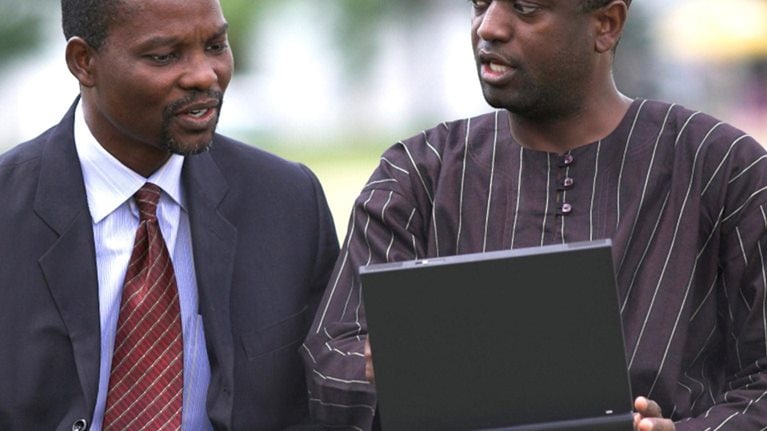The White House has invited some 50 African heads of state to Washington, DC, this week, presenting a historic opportunity to deepen US ties to the continent. But it would be a mistake to assume that the benefits of the US–Africa Leaders Summit will flow primarily to Africa. There is huge economic potential for the United States, too.
Africa is transforming from a continent in need of assistance to a continent of opportunity. Its economic growth is today second only to the East Asia region, which includes China,1 and Africa was home to 8 of the world’s 15 fastest-growing economies between 2000 and 2013. Indeed, the continent’s GDP of more than $2 trillion in 2013 is now larger than India’s (Exhibit 1).
Africa’s economic growth accelerated after 2000, making it the world’s second-fastest-growing region.

Investors around the world have taken notice. Private-capital flows to Africa totaled $545 billion from 2003 to 2012, surpassing remittances and official aid. Yet the United States lags well behind Europe, BRIC,2 and the Middle East in terms of the amount of foreign-direct investment (FDI) it sends to Africa. Moreover, the US share of African trade stands at only 4 percent.
This may be a missed opportunity. Africa offers a higher rate of return on FDI than most emerging economies—in sharp contrast to returns that foreign investors earned 20 years ago (Exhibit 2). But to date, economic engagement between the United States and Africa has been limited relative to its potential, and much smaller than Europe’s and Asia’s economic engagement with Africa.
The rate of return on foreign direct investment in Africa is higher than in most emerging markets.

Increasingly dynamic economies
After decades of disappointing growth, Africa’s economic performance has improved since the turn of the century.3 Real GDP grew at a compound annual rate of 4.9 percent between 2000 and 2013, more than twice its pace in the 1980s and 1990s. The continent weathered the Great Recession well, and a consensus of mainstream forecasts projects that annual growth will, on average, be 5.8 percent from 2014 to 2019.4 In addition, sub-Saharan economies are growing even faster than the continent as a whole. In 2013, their average GDP growth was 5.2 percent, and forecasters expect average annual GDP growth of 6.2 percent to 2019.
Africa has benefited from the surge in commodity prices since the turn of the century. The price of oil has increased from less than $20 a barrel in 1999 to around $100 a barrel today. Prices for minerals, grain, and other raw materials also soared on rising global demand. However, the continent’s growth has not solely been a function of booming commodity prices. We estimate that natural resources, and the related government spending they financed, generated only one-third of Africa’s GDP growth from 2000 to 2008. Since the global recession dampened commodity prices, they have contributed even less. The majority of Africa’s growth is being driven by other sectors of the economy, including wholesale and retail trade, transportation, telecommunications, and manufacturing. Evidence of the diversification of African countries is the fact that those with and without significant resource exports had similar GDP growth rates.
Africa’s accelerated growth over the past 14 years owes a great deal to improved macroeconomic and political stability and to structural economic reforms. Government action to end armed conflicts, lower inflation, and reduce public-sector debt has created a more stable environment for businesses. A range of microeconomic reforms has energized markets. Governments have privatized state-owned enterprises, increased the openness of trade, lowered corporate taxes, strengthened regulatory and legal systems, and provided critical physical and social infrastructure. Nigeria, for example, privatized more than 116 enterprises between 1999 and 2006, and by 2013 had privatized its entire electric-power sector. Morocco and Egypt struck free-trade agreements with major export partners. Although governments across Africa can do a great deal more to create a business-friendly environment, these important first steps have enabled a private-business sector to emerge.
The fruits of this structural reform have been an African productivity revolution. After declining through the 1980s and 1990s, the continent’s productivity started growing again in 2000, averaging 2.4 percent per annum between then and 2013.5 Productivity gains took place across countries and sectors.
Africa’s growth has also been due to the rising number of households with discretionary spending. According to our research, consumer spending is projected to reach $1.4 trillion per year by 2020, from $1.15 trillion in 2012. Already, more than 100 million households have sufficient income to spend on discretionary goods and services, as well as the basics, and the continent has more middle-class households (defined as those with annual incomes of $20,000 or more) than India.
Africa remains overwhelmingly a rural continent, but its cities are a growing economic force. Today, 40 percent of the continent’s one billion people live in cities—a proportion roughly comparable to China’s population and higher than India’s. By 2030, that share is projected to rise to 50 percent, and Africa’s top 18 cities will have a combined GDP of $1.7 trillion.6 Urban expansion is spurring the construction of more roads, buildings, water systems, and similar projects. Of course, urbanization needs to be managed to avoid creating slums, gridlock, and a deteriorating quality of life as cities grow. And more infrastructure investment is needed across Africa.
In a world where many countries are aging, including China, Africa stands out for the relative youthfulness of its population—a potential demographic dividend. By 2035, the continent is set to have the largest working-age population of anywhere in the world—larger than in China or India. The task ahead will be for Africa’s leaders to bolster education and provide young people with the skills they need to secure employment, and to accelerate job creation. In 2012, only 29 percent of Africa’s labor force had stable, wage-paying jobs.7 The rest were employed in a variety of self-employment and household enterprises, scraping a living from subsistence agriculture or informal jobs in urban areas.
Africa’s global opportunity
Africa’s trade ties with the world are expanding. In 2012, the continent’s flows of goods, services, and finance were worth $1.6 trillion, or 82 percent of GDP, up from just $400 billion, or 60 percent of GDP, in 2000 (Exhibit 3). As in other countries, goods flows are Africa’s largest, with inflows and outflows worth $1 trillion in 2012. Flows of services and finance are smaller, totaling around $300 billion each.
Africa’s trade and capital flows grew to 82 percent of GDP in 2012.

Although commodities continue to be a large share of Africa’s exports, they account for less than half of goods exports. Capital-intensive goods, labor-intensive manufactured goods, and knowledge-intensive manufactured goods together comprise the majority of the continent’s exports (Exhibit 4). This is a clear sign of structural change in Africa’s economies, although the shift toward manufacturing and services needs to be accelerated. In many individual African countries, the share of manufacturing in the economy has been stagnant or even declining over the past decade.
Natural resources account for less than half of Africa’s exports, and exports of manufactured goods are growing.

Today may present a historic opportunity to boost Africa’s goods flows even further. As wages rise in China, production is shifting to lower-wage Asian economies—and to some African countries. Manufacturing already receives most of the FDI in some countries including Morocco, Algeria, South Africa, Mozambique, and Egypt (Exhibit 5). On current trends, manufacturing is set to create eight million jobs by 2020, a testament to wages and productivity levels that are competitive with other global low-cost manufacturing hubs.8 The evidence shows that the productivity of African workers in well-managed factories is comparable with that in other countries, although overall costs are higher because of poor logistics and infrastructure, as well as cumbersome bureaucratic procedures. Africa can build on this progress and develop industrial clusters in agro-processing industries, such as food and beverage manufacturing, textiles, leather goods, and wood products.
The destinations for announced foreign investment in Africa

Still, Africa is not as fully engaged in the global economy as its potential suggests it could be. The new McKinsey Global Institute Connectedness Index ranks countries based on goods, services, finance, people, and data and communication flows. It adjusts for the size of countries, and it reflects both inflows as well as outflows, both of which contribute to economic growth. The index shows that Africa ranks the lowest of any region in the world on its connections to the global economy.9
Despite the continent’s low overall ranking, some African countries, particularly those with the most diversified economies, such as South Africa, Morocco, Egypt, and Nigeria, are rapidly becoming more connected to the rest of the world (Exhibit 6).10 South Africa is the African economy most connected to the world across all five flows, even though it ranks only 49th on the global index. Morocco ranks 53rd globally but is the second most connected economy in Africa, having risen 26 places since 1995. Morocco’s rise reflects a growing automotive industry that has attracted foreign investment and generated $2.7 billion of exports in 2013 and expanding tourism, offshore services, and agricultural exports. Along with Mauritius, which gained 28 places on the global index since 1995, it shows that large gains are possible with a concerted effort. Senegal has gained 14 places during this period.
The Africa global connectedness index

Underlying the expansion of global flows of goods, services, finance, and people is the soaring exchange of data and communication across borders through cross-border Internet traffic and international phone calls. Yet Africa risks being left behind in a growing “digital divide.” More than 720 million Africans have mobile phones, some 167 million people use the Internet, and 52 million are on Facebook. The numbers are rising rapidly, but more than three-quarters of the continent’s one billion people remain unconnected to what is supposed to be a “worldwide” web.11 In fact, the Internet contributes just 1.1 percent of Africa’s GDP overall, compared with 1.9 percent across developing economies.
The situation may be changing. Africa’s cross-border Internet traffic grew 70-fold between 2005 and 2013, faster than in China or Latin America. The new undersea cables circling the continent should open up new opportunities, although laying the cables to bring that broadband access inland to cities and countries without easy access to the coast will be challenging. The potential in Africa’s growing cities is very large. A McKinsey survey in 2012 found that 51 percent of urbanites had accessed the Internet in the previous month and that 54 percent own Internet-capable devices.
Improving US engagement
The historic Washington summit is an opportunity to address challenges on both sides—the relatively low levels of economic engagement with Africa on the part of the United States and the unevenness of economic development in Africa despite its enormous potential.
The US engagement with Africa lags the rest of the world. It accounts for just 9 percent of the continent’s trade, and that trade is growing more slowly than that with every other region of the world (Exhibit 7). US–African trade is less than one-fourth the volume of Africa’s trade with Europe, and 40 percent smaller than Africa’s trade with China. On FDI, the United States ranks as only the fifth-largest source, behind Western Europe, the Middle East, the BRIC nations, and the rest of Asia (Exhibit 8).
The United States accounted for just 9 percent of Africa’s trade in 2012.

US FDI into Africa is small compared with that coming from other regions of the world.

Summits can too often be mere talking shops and photo opportunities. The importance of this gathering will materialize only with concrete action. The African Growth and Opportunity Act, signed into law in 2000, was aimed at increasing African exports to the United States and is now up for renewal. But to date, too much of the trade and investment between the United States and Africa has been related to oil and other commodities. The range of interactions needs to broaden if Africa is to fulfill its economic potential. If it does, more US businesses could benefit from the continent’s investment opportunities. We offer several priorities for accomplishing this:
- Raising US investment in Africa’s infrastructure from both public and private sources. Power Africa is a 2013 US initiative to double the number of people with access to power in sub-Saharan Africa. It aims to enable public and private capital to expand power generation and help electrify the continent. This initiative could be expanded given the size of the need in Africa. And energy is not the only infrastructure challenge that Africa faces. The McKinsey Global Institute estimates that Africa needs $2.6 trillion in infrastructure investment by 2030, including highway, water, and telecommunications infrastructure.
- Building the next generation of African leaders. Equally important will be measures to help the continent to develop a new generation of business and political leaders. The White House’s Young African Leaders Initiative is a step in the right direction. But more can be done. One useful step would be to dramatically expand the number of African students who can attend US universities for both undergraduate and graduate programs. Shorter-term exchanges, through the Fulbright Fellowship program and other opportunities, can also have impact.
- Improving Africa’s business climate. Greater trade with and investment in Africa from the United States will, to a large degree, depend on confidence about the macroeconomic and business environment. African countries must continue to strengthen the rule of law, ensure the sanctity of contracts, and make arbitration available in the event of disagreements. Foreign investors also want a level playing field with local firms. In practical terms, this requires limiting the preferential treatment of locally owned companies, as well as the removal of withholding tax on foreign remittances and ceilings on the repatriation of profits and capital by foreign firms. There is also more to be done in African countries on simplifying and standardizing business regulations, raising the efficiency of obtaining permits and approvals, and shortening the time it takes for companies to obtain approvals needed to set up operations.
- Facilitating US investment. Several African governments already have investment and trade promotion agencies to facilitate increased global engagement. For their part, African countries can do more to reach out to US investors and companies. Too many US executives are simply unaware of the opportunity. African countries can help them navigate regulations and local customs. Many developing economies have developed explicit strategies for attracting FDI and have created investment agencies that help foreign companies identify opportunities.
Leaders from across Africa will meet in Washington, DC, between August 4 and 6, 2014, for the US–Africa Leaders Summit, the first such event of its kind.


